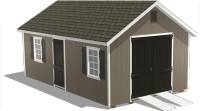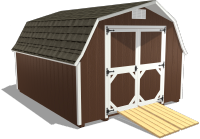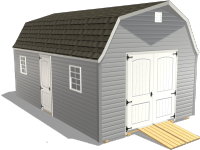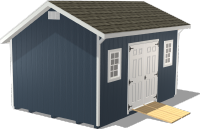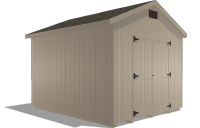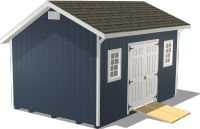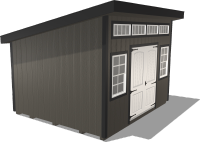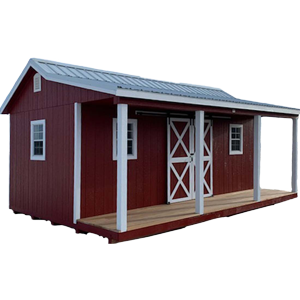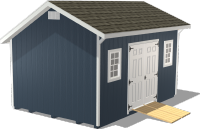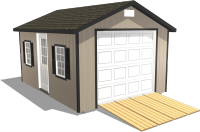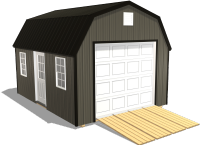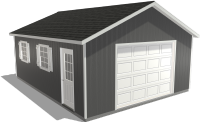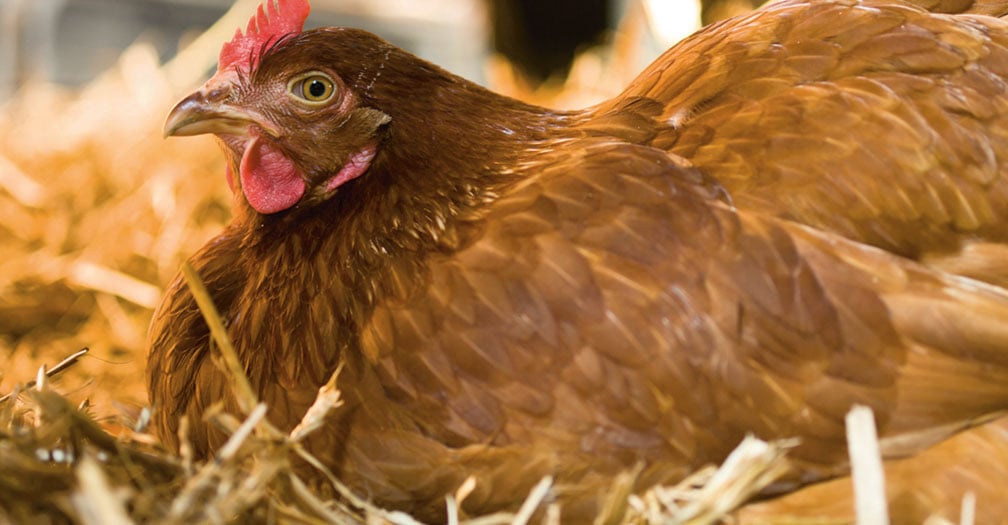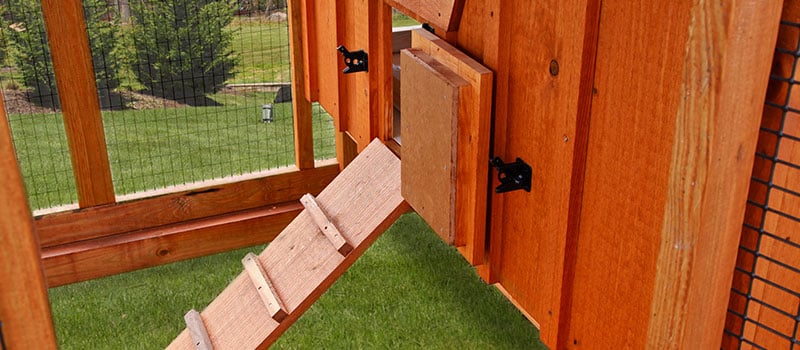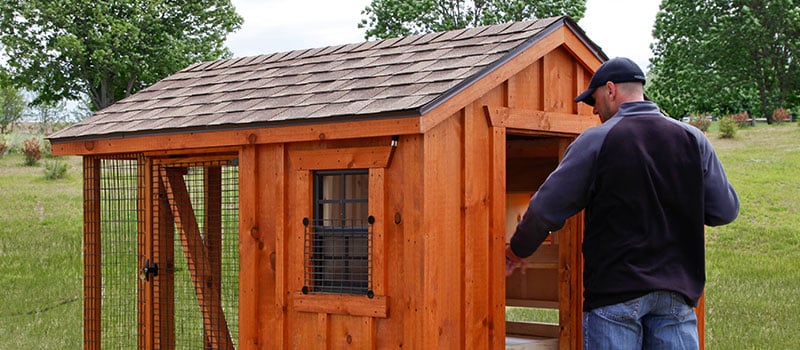Chicken Coop Essentials: Providing Shelter from Extreme Temperatures
by Dakota Storage Buildings, on October 28, 2020
Keep your chickens cool in the summer and warm in the winter without electricity.
Considering all the eggs they provide, it’s safe to say that chickens are givers. You can give back by taking great care of them. But some comforts, like air conditioning and heating, may not be feasible. Not to mention, electric solutions like heaters can pose a fire hazard in highly flammable chicken coops.
Still, it’s important to keep your chicken coop comfy, and your chickens protected from heatstroke and frostbite. Starting with a quality, well-insulated chicken coop can go a long way to addressing these concerns. Beyond that, there are a few tricks of the trade that can help.
Before we dive into specifics, the first thing to keep in mind is that some backyard chicken breeds handle cold better than others. Breeds with large combs and wattles may be more susceptible to frostbite. On the flip side, these same breeds are able to cool themselves easier in the summer than chickens with small peacombs.
Choosing the best breed for your climate is a great place to start. In addition, it’s good to remember that young chicks can’t keep themselves warm the same way that fully feathered adults can. You’ll want to take extra measures to keep these little ones cozy.
While cold weather can be a concern, extreme heat tends to be more immediately life-threatening to most of our feathered friends, so let’s start with ways to protect them from the sweltering summer sun.
How To Keep Chickens Cool in the Summer
It may surprise you to learn that even temperatures of 80 degrees can verge on the uncomfortable for your chickens. As the mercury nears the 90 mark, egg production will decrease and even cease around 100 degrees.
Chickens can’t sweat to cool themselves, so unusual spikes in temperature can be especially dangerous and may even cause death. This is not the way to roast chicken.
Signs of heat stress or heatstroke may include:
- Panting, open beaks and heavy breathing
- Lethargy, change in egg production or other unusual behavior
- Decreased appetite
- Pale combs and wattles
7 Provisions To Beat the Heat That Are for the Birds
1. Shady Spaces — Place your chicken coop where there’s plenty of shade. If you don’t have adequate shade available from trees or a larger structure, try a patio umbrella or sun sail.
2. Extra Drinks — Fresh water is important year-round, but you’ll want to add a few more water dishes in the summer and keep them topped off on extra hot days.
Tip: Fill and freeze water bottles to keep the water supply cool.
3. Water Play — Use a misting attachment for your hose on scorchers, or put a few inches of water in a baby pool. Add a frozen bottle of water to the pool, and your chicks may have the coolest spot on the block (sunglasses optional).
4. Frozen Treats — For a cool, tasty summer treat, chop and freeze fruit like watermelon or strawberries.
5. Summer Breeze — Keep your chicken coop cool with proper ventilation. A screened window allows for cool breezes to flow through while keeping predators out.
6. Spa Treatment — Chickens will naturally use dust baths to beat the heat. You can make a cooling perch in their favorite dusty spot by freezing water in an old milk jug and covering with a towel.
7. Clean Sweep — The dog days of summer may not be the best time for the deep litter method since this can create unwanted extra warmth. Sweep the chicken coop out regularly and make sure they have a nice place to roost.
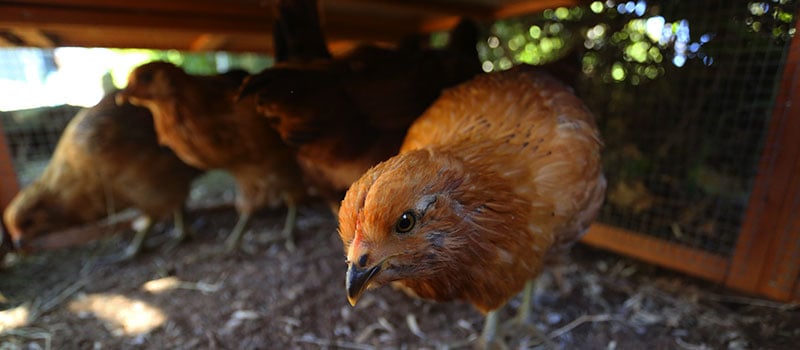
How To Keep Chickens Warm in the Winter
Feathers prove to be quite an amazing design — they block the wind and create a toasty layer of warm air against a bird’s body. There’s a reason people use feathers for bedding! This natural insulation will keep chickens warm in temps as low as -20 degrees, providing the wind isn’t severe, and your chickens don’t get damp from snow or icy conditions.
Provide High-Quality Feed & Fresh Water
Consider adjusting your chicken’s diet in the winter to meet their needs. Remember, not all chickens are alike. Molting chickens may need more protein, but others may need to bulk up on carbs. Check with your feed supplier or vet for recommendations. For a treat, you might want to occasionally offer warm oatmeal, cracked corn, or mealworms.
It’s also important to check the water supply regularly to make sure it doesn’t freeze. Relocating their water source to inside the chicken coop can help, but make sure your setup will prevent the dish from getting knocked over.
Tip: Place the water container inside an old tire that’s packed loosely with straw.
Watch for Frostbite
Keep an eye out for dark or blistered wattles and combs. If a severe chill sets in, chickens in danger of frostbite need to be warmed until feathers dry. Gentle use of a hairdryer can help speed things up. But hopefully, the following preventative measures will help ensure things won’t come to that.
3 Musts To Keep Your Chicken Coop Cozy
The internal temperature of an adult chicken is 105 to 109 degrees. So, when chickens are snuggled together, their natural combined warmth will go a long way on cold nights. But during sudden, severe, or prolonged cold snaps, this may not be enough warmth. A protective coop is a must.
1. Dry Spaces — Add extra newspaper, straw, etc. to the chickens’ bedding and check to be sure it stays dry. Throw in a few herbs to keep things smelling fresh and keep rodents away. Winter may be a great time to try the deep litter method for extra insulation. However, this method can pose a health hazard to your chickens if proper ventilation and moisture balance are not maintained. You might also cover any frozen ground in the run area with straw — chicken feet are susceptible to frostbite!
2. Secure Coop — As you head into winter months, inspect your chicken coop for any holes or cracks that allow predators or bitter wind to get in. You also want to make sure that the roof is watertight. Maintaining proper ventilation will prevent stagnant moist air from getting trapped inside. Vents near the top of the coop keep the wind away from chickens while allowing humid air to escape.
3. Roosts — A sturdy roost gives chickens respite from the cold floor at night. It also gives them a place to fluff up their feathers and huddle together for warmth.
Tip: If you find a loner hanging out in the corner on dangerously cold nights, gently tell her this is no time to be anti-social and move her to the roost with the others.
Year-Round Chicken Coop Comfort
In addition to nesting boxes and roosts, there are a few other things to look for in a quality chicken coop that can help keep your birds happy and healthy.
- Durable flooring that resists decay and warping
- Special roofing sheathing and insulation to help maintain interior temperatures
- An outdoor run where chickens can move around freely
- Use an indoor/outdoor thermometer to monitor temps and humidity levels
Having backyard chickens is a rewarding endeavor, and with the right chicken coop and set up, it’s not difficult to keep them comfy. Want to learn more?
Our Guide, Evaluating The Best-fit Quality Chicken Coops, is chock-full of more important info you’ll want to know. Our guide covers what every chicken needs to be healthy and happy, key features that every coop should include, and what coop options are available.




